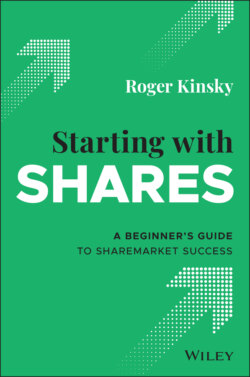Читать книгу Starting With Shares - Roger Kinsky - Страница 25
Understanding some basics
ОглавлениеThe following are some common terms you're likely to encounter as you start investing in shares. Some of them are a bit ‘jargony’, but understanding them is necessary as you progress along your journey.
Common share investing terms include:
Bulls and bears: These terms have been around for a long time and no‐one is exactly sure how they came about. Bulls are optimists who believe the market will rise and, therefore, they want to buy shares, whereas bears are pessimists who believe the market will fall and, therefore, want to sell shares.
Capital: This is just a fancy word for money used in business.
Portfolio: Your portfolio is the total of the shares you own. Your portfolio value changes as share prices change, so you can know its value only at a certain point in time. Your portfolio value also changes if the number of shares changes. The value rises if you add more shares and falls if you sell some of the shares you currently own.
Securities: A security is a tradeable financial asset. Because shares have value and are tradeable, shares are one form of security. Many other types of security are available, including property, bonds and cash.
Securities exchange: Shares are traded on a securities exchange (previously known as a stock exchange). Before a company can be listed with an exchange (and in order to remain listed) the company needs to satisfy stringent requirements of the exchange, the Australian Tax Office (ATO) and Australian financial laws that are enforced by ASIC (Australian Securities and Investments Commission). If the company can jump through these hoops, and pay the required fees, it can be listed with the exchange and traded on their market. The company is now a listed public company. (I discuss this process in a little more detail in the section ‘Making shares available for trading’, later in this chapter.)
Share registry: Most listed companies in Australia can't be bothered keeping track of the details of all their shareholders, because it's fiddley work and isn't really part of the business strengths of the company. So companies usually farm the shareholder work out to a share registry. This is an organisation set up to do precisely that — keep records of the details of all shareholders and their shareholding. Australia has several share registries, of which the most widely used ones are Computershare and Link Market Services. You can easily find out which share registry the company uses because it will be stated on any shareholder communication you receive.
Stocks: This is just another name for shares and is often used to mean the total of the shares owned in a company. Don't get confused with ‘stock’, which refers to goods kept on hand by the business — that is, the materials or partly finished or finished products owned by a business. In this book, I mostly use the word ‘shares’ but sometimes I use ‘stock’, particularly when referring to all the shares in a company.
Stockmarket: The trading market for shares is, naturally enough, known as the stockmarket or sharemarket. In Australia, the largest market is the Australian Securities Exchange (ASX) and it is most likely the one you'll use, but a number of smaller exchanges are also in operation.
Trading: Trading is the process of purchasing or selling shares.
Trading hours: As you might expect, an exchange isn't open for trading on a 24/7 basis. In Australia, the opening hours are 10 am to 4 pm, Monday to Friday, with the exchange closed on public holidays. Nowadays, you can place orders with many brokers outside of exchange trading hours but the order can't transact until the exchange is open for trading.
